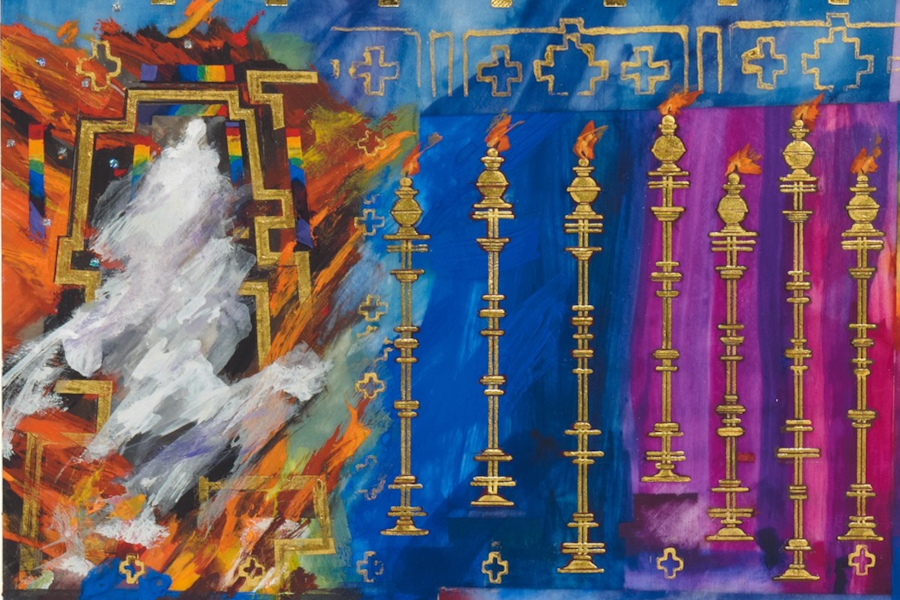Revelation 1
Revelation opens with a reference to John, who has recorded what he has seen on the Isle of Patmos, to be read aloud to the seven churches in Asia Minor (vv. 1 – 3). This is followed by the Pauline greeting — Grace and Peace, the Petrine blessing — a Kingdom of Priests, and the Lord’s declaration — “I am the Alpha and Omega, who is, and was, and is to come” (vv. 4 – 8).
In sharing about his encounter with the Risen Lord in a meeting for worship, John hears a “megaphone voice” (a voice like a trumpet), turns around to see the voice, and falls down as though dead at this Christophany. He sees one like the Son of Man, in a long robe and sash, with white hair, eyes of fire, brazen feet, and a voice as cascading waters (vv. 9 – 15).
In his right hand are held seven stars, from his mouth came a two-edged sword, and his eyes were like the blazing sun (v. 16). When I was at the national museum in Rome a few years ago, I saw a Roman coin featuring baby Domitian (Emperor from 81 – 96) with seven stars in his hand. This vision of Christ is a direct challenge to imperial hegemony in the late first century.
And, it’s not Peter who has keys to the Kingdom, but the Lord who holds the keys to death and Hades in his hand — the one who is the first and the last (v. 17). John is then instructed to write to the seven churches in the region — the seven golden lampstands, who are guarded by angels — the seven stars held in the Lord’s right hand.
We will now learn more about what is and what is to come (vv. 18 – 20).

Revelation 2
Revelation 2 presents the first four messages of Christ to the angels over the churches of Asia Minor. In each case, their situation is known, and each is given a commendation and a confrontation, calling for change. Note the beautiful Saint John’s Bible (Vol. 7) painting by Donald Jackson — “Letter to the Seven Churches with the Heavenly Choir” — connecting ancient and modern images together.

For Ephesus, the central setting of the Johannine situation, they are commended for good works, patient endurance, and intolerance of evil doers; they also hate the works of the licentious Nicolatians. And yet, they have lost their first love — rooted in a sense of dependence upon, and need for, God. To the conquerors is given permission to eat of the Tree of Life and the Paradise of God (vv. 1 – 7).
For Sardis, their affliction and poverty are known, despite being rich, and they resist the pressures of Judaizers faithfully. Yet, they will suffer persecution and imprisonment; so the admonition is to be faithful unto death, whereupon they will receive the crown of life (vv. 8 – 11).
For Pergamum — the other city in the region competing with Ephesus for guardianship of the Roman temples — this is referenced as the place where Satan has his imperial throne. They hold fast to the Lord’s name and have not denied it; Antipas, the faithful witness (burned to death in a copper kettle, according to tradition) inspires further faithfulness against false teachers and their sinful practices. Those who conquer will be given hidden manna and a white stone of Kingdom membership (vv. 13 – 17).
For Thyatira, their works of love, faith, service, and endurance are known, but they are challenged because they tolerate the teachings of a prophetess labeled “Jezebel,” who invites eating food sacrificed to idols along with fornication. Non-repentance will lead to death, but those who overcome will be given authority over the nations (vv. 18 – 28). These messages were relevant back then, and they still are today.
Revelation 3
John continues the letters of Christ to the churches of Asia Minor in Revelation 3, completing the circuit that ministers traveled among the churches. To Sardis, the message is to “wake up, and strengthen what remains,” even if at the point of death (v. 2). As Sardis had previously suffered nighttime sieges, the message of one coming as a thief in the night would have aroused attention (v. 4).
To the church at Philadelphia — in tension with local Jewish family and friends — this community is given the promise that they are given an open door in the legacy of David that no one can shut (v. 7). In their faithfulness, they will become a pillar in the emerging temple of God in the New Jerusalem (v. 12).
To the church in Laodicea — a site of healing and wealth — it is spiritual wealth from Christ that counts, gold refined by fire, and the healing salve that the Lord avails (vv. 18 – 19). And, to all audiences in every generation, this final word stands as an invitation to abide in Christ and he in us (v. 20):
“Listen! I am standing at the door, knocking; if you hear my voice and open the door, I will come in to you and eat with you, and you with me.”
Revelation 4
Apocalyptic literature is highly political. It most often is employed by groups that believe in their cause but feel they overpowered in human terms. Thus, visions of God breaking into human history, setting things straight, and making things right gives hope to the faithful, empowering their resistance.
Such is clearly the case for the opening scene of Revelation 4. With a glorious vision of a heavenly throne, with 24 elders — each on their own thrones, dressed in white robes with golden crowns on their heads — surrounded by seven spirits of God and four living creatures, thunder and lightning signal the upheaval of the present world-order, preparing the way for a new day to come (vv. 1 – 8).
The four living creatures (lion, ox, human, eagle) are singing a hymn of praise to the Lord (the basis for a familiar hymn), giving honor and glory and praise:
“Holy, holy, holy,
the Lord God the Almighty,
who was and is and is to come.”
And what are the elders doing (perhaps representing the twelve tribes of Israel and the twelve apostles of Jesus)? They cast their crowns before the one who lives forever, singing (vv. 9 – 11):
“You are worthy, our Lord and God,
to receive glory and honor and power,
for you created all things,
and by your will they existed and were created.”
Not surprisingly, the hymns of Revelation have rightly made it into the worship life of believers in later generations, and rightly so. Note here the beautiful painting by Donald Jackson, in Vol. 7 of The Saint John’s Bible: “Heavenly Choir.”

Revelation 5
Revelation 5 continues the throne scene with a scroll with seven seals. But no one is worthy to open the scroll other than the Lion of Judah, the root of David (vv. 1 – 5). Then, the Lamb that had been slaughtered takes the scroll, and this is followed by the elders and the living creatures breaking into song (vv. 6 – 12):
“Worthy is the Lamb that was slain
to receive power and wealth and wisdom and might
and honor and glory and blessing!”

One can hear the chorus of Handel’s Messiah here, followed by all the creatures on earth singing (vv. 13 – 14), capped by a resounding Amen!
“To the one seated on the throne and to the Lamb
be blessing and honor and glory and might
for ever and ever!”
With rejoicing like that going on in the heavens, we can imagine that God’s victories in the here and now are indeed in the works, and for that we can be thankful in every age and setting.
Revelation 6
Revelation 6 begins the opening of the first six of the seven seals opened by the Lamb. After each of the first four, the four living creatures invite: “Come!” to the seer.
With the escalation of chaos, suffering, and death, each of the seals gives way to further calamity, until even the powerful and the rich are reduced to seeking shelter in caves, slave and free alike (vv. 12 – 17).
Just a few years earlier (66−73 AD), Rome had invaded Israel and destroyed the temple in Jerusalem. Josephus numbers those who were killed to be over a million, and rich and poor alike fled Jerusalem and other cities, seeking shelter and moving to other regions. It was during that onslaught, that John, according to Eusebius, moved to Ephesus.
As the three emperors of the Flavian Dynasty (Vespasian, Titus, Domitian: 69 – 96 AD) sought to subdue Judaism, and later, Christ followers, the message that the Lamb will have the last word surely brought hope to followers of Christ in the throes of Domitian’s reign, where he began requiring public emperor worship (81−96).
And, that vision likewise brings hope to the beleaguered faithful of every generation. The Lamb will indeed have the last word.
Revelation 7
Revelation 7 delivers hope, that no matter how bad things are for faithful believers in the world, their tribe and branch will never be stamped out nor eradicated by the powers that be. There will always be a surviving critical mass (12,000), and a robust remnant will always remain (vv. 1 – 8).
Further, the vision of a vast multitude — impossible to count — clothed in white and faithful to the end, bolsters hope: waving palm branches (cf. John 12:13) and singing (vv. 9 – 10): “Salvation belongs to our God who is seated on the throne, and to the Lamb!”

And, their chorus is joined by that of the angels around the throne, declaring blessing, glory, wisdom, thanksgiving, honor, power, and might to God forever (vv. 11 – 12).
Those robed in white have come faithfully through the ordeal, and their clothes have been made clean by the blood of the Lamb, who now becomes their shepherd.
They will never hunger or thirst anymore, and they will now drink from the springs of living water, with God wiping away every tear from their eyes (vv. 13 – 17) — a great promise of protection, provision, and hope for the faithful then and in every generation. God wins!
Reflections © Paul Anderson, 2024. Used by permission of the author.
Find more reflections like these by joining Paul Anderson’s Daily Bible Readings Groups on Facebook or LinkedIn.
Images by Donald Jackson © 2002. The Saint John’s Bible, Saint John’s University, Collegeville, Minnesota USA. Used by permission. All rights reserved. Learn more at stjohnsbible.org.
Text First Published December 2023 · Last Featured on Renovare.org January 2024


